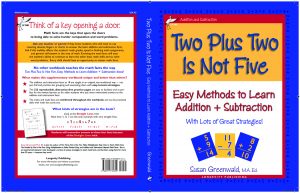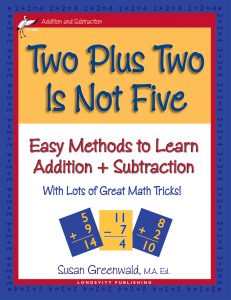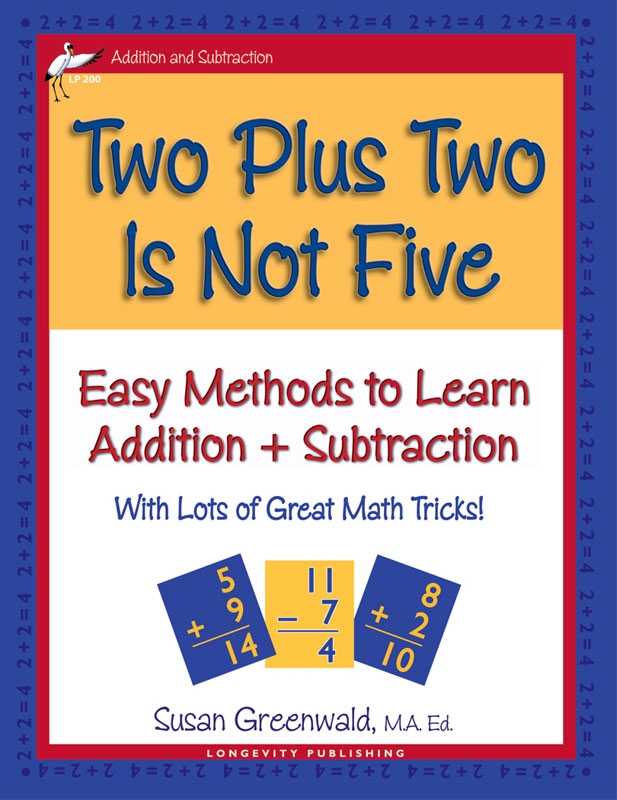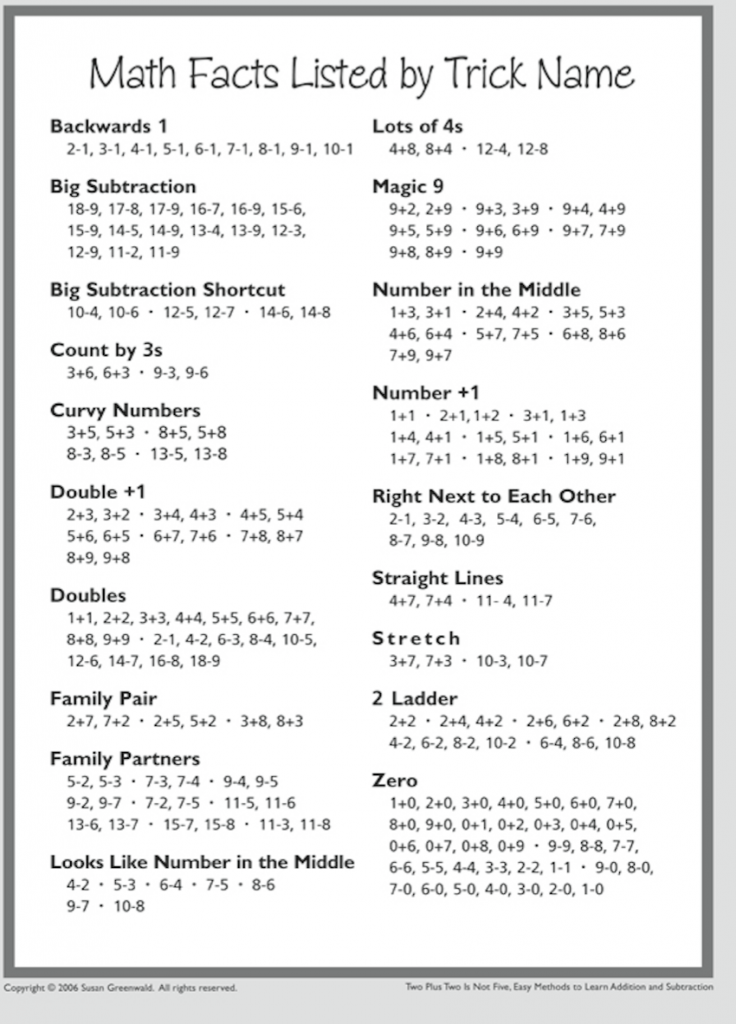Longevity PublishingThis is such a great series. My special needs child used both the Addition/Subtraction and the Multiplication/Division books and mastered the skills by doing one lesson each a day. The lessons are relatively easy and progress the student very slowly and systematically.
There was almost no frustration. We tried a lot of approaches, and this was the absolute best.
Easy to Use!
02/07/2022
Longevity PublishingThis Twitter post was a reply to one of mine about my books:
"These books have been the greatest help for my son. He understands math very well...but memorization is a struggle for him. These are the best solution we have tried! (Out of 7 ) twitter.com/twoplustwonot5… Thank you for your ingenious math help!"
Daniella Garcia
07/19/2020
Longevity PublishingI want to start with thanking you for your books. I had tried different books for my daughter but the "Two Plus Two" book was the one when she finally "got things". Before trying your book, I had given up and assumed that my daughter will always be behind in Math. But I now realize that each kid learns things differently. My daughter is almost done with the "Two Plus Two" book and is working on regrouping by using the "Beyond Math Facts" book.
Rushabh
06/24/2020
Longevity PublishingThank you very much. We received the books yesterday! He has already gone through the pages you sent! I think because of the fun way the books are, it doesn't stress him and he has soared through the 24 pages with such excitement and asked each day if the books have come yet!
Myra, Houston TX
01/21/2019
Longevity PublishingI love, love, love it! I think the "pudding proof" was when I had a few parent conferences towards the end of the year and they told about how their kids talked about the strategies at home e.g. magic nine.
Catherine McDowall, 2nd grade teacher, St. Martin’s School, Australia
01/23/2019
Longevity PublishingWe are very excited to have such an awesome resource for our students to work on building fact fluency. Teachers and students are loving it! 
Kelly McKay, Principal, Rabun County Primary School
12/11/2018
Longevity PublishingWe love it, and our kids really get excited about working on it each week.
Beth Scruggs, 2nd Grade Teacher, Rabun County Primary School
12/11/2018
Longevity PublishingI have seen an improvement with my students fact fluency since started using this. It is quick and easy to use...takes about 5 min at the most each day-and students really like the tricks. 
Carla Kilby, 2nd Grade Teacher, Rabun County Primary School
12/11/2018
Longevity PublishingI really like the book and all of the tricks in it. It doesn't take up too much of our time each day, and it's great practice for the students.
Heather Stockton, 2nd Grade Teacher, Rabun County Primary School
12/11/2018
Longevity PublishingWe've repeatedly been asked if we knew of a product to help with memorization of addition and subtraction facts. We've FINALLY found a resource we feel we can wholeheartedly recommend. Susan Greenwald's workbook offers lots of practice and reinforcement and uses some great memory tricks as well. Plus, it's totally reproducible!
Trigger Memory Systems
06/01/2007
Longevity PublishingI have a 9 year-old daughter going through the multiplication book like a champ, and ditto on my 6 year-old son with the addition book! I assign them one page a day in addition to their math curriculum and it's working perfectly. Couldn’t be more pleased!
Shannon Hughes, Homeschool parent
02/19/2018
Longevity PublishingI absolutely love your books. My niece used Two Plus Two Is Not Five, and it massively helped her. I am so thankful for your books.
Kate
09/12/2017
Longevity PublishingThe books are beyond awesome, structured well, and my grandson loves working with them. He is developing great confidence and better understanding of addition as well as subtraction families. Prior to using the workbooks, subtraction was overwhelming but now he is doing great. It is nice to have something tangible as opposed to everything usually being computer driven these days. Thank you for creating such a wonderful series including addition, subtraction, multiplication and division.
Lori G., Grandparent
08/10/2017
Longevity PublishingMy five children have used the multiplication and division books to learn and master their math facts. They really work! Friends (in homeschool groups) and family all tell me that my kids know their facts.
Angie, CHEC attendee
06/16/2017
Longevity PublishingI'm using your books with all three of my kids, and my oldest is finishing division soon. Your books work, and are magical. We are currently road tripping across the country and my daughter does five pages each day, with no fuss, and actually enjoys it. She progresses with minimal guidance, and we are very satisfied.
Justin, Key West, FL
06/12/2017
Longevity PublishingI didn’t know my son was counting on his fingers in 2nd grade. I needed a curriculum that focused on retention and reinforcement. After speaking with you on the phone, I was skeptical because nothing was working out, but your program sounded like it was worth our time. We started with the 1st book and are now in the 3rd, which is multiplication. His exact words are, “Mom, this is so easy!” I should send in a video to show you how fast he can do a page. It is amazing! I couldn’t be more pleased with how these books are written. They focus on making math fun and easy, and my child knows his math facts from memory….no more counting on those fingers!!! I am forever grateful, and I have shared these books with several friends.
Donna, Lafayette, LA
03/20/2017
Longevity PublishingI am currently using Two Plus Two is Not Five with my 2nd grade son, and thank you for this resource. My son made adequate progress in math in kindergarten, but flat lined in 1st grade, initially making 2nd grade difficult, scary, and unsuccessful. Traditional drill and practice, even time delay, were not moving his fluency or automaticity with math facts along. I was really at a loss, and as a school psychologist by training, perplexed. Your “tricks” have been just the instructional component he has needed to break the habit of finger-counting and to commit these facts to memory for him. I appreciate the progression of skills and have found that he is working exactly where he needs to be. I am purchasing the multiplication book in preparation for next year to have for when we complete this book. Thank you. I can only imagine how many children you have helped through this resource, but you can add one young man in Lexington, KY to your list!
Leslie, Vaughn
03/17/2017
Longevity PublishingAs a homeschool mom of four, I am always looking for the best way to teach my kids who all have different learning styles. I came across these math drill workbooks a couple of years ago when my oldest was struggling to memorize addition math facts. Since then, we have worked through addition, multiplication, and are now on the division workbook! The tricks are easy for them to remember, and the daily drill practice is perfect! Grateful we found them when we did!
Sharae, A happy homeschool mom
Sharae, Happy Homeschool Mom
01/30/2017
Longevity PublishingThese books are wonderful for all levels.
Mollie Fauver
4th Grader Teacher
07/15/2016
Longevity PublishingWe got your program Tuesday and started right away. My daughter loves it. I think she has a whole new outlook on math. She will not dread having to do it next year and will not call herself stupid anymore. You are a miracle worker. I'm sure we will need the division book soon. As soon as, we finish addition, we are moving to multiplication. Thank you so much. One very happy mom!
Stella Rodriguez
Stella Rodriguez
07/16/2015
Longevity PublishingOdyssey Elementary in Falcon D49 is offering a revolutionary curriculum for students who exhibit dyslexic tendencies. The books by Susan Greenwald have been an amazing addition to our math instruction. Her books make learning easier for students who struggle.
Amy Willis
4th Grade Lex Teacher
07/15/2016
Longevity PublishingThree new reviews were posted on Amazon.com for Five Times Five Is Not Ten and Two Plus Two Is Not Five.
1. Better than Mathnasium! By Sarafinaon December 3, 2015 for Two Plus Two Is Not Five.
Great book! My daughter struggled in math. We paid lots of money to send her to Mathnasium and in the end she learned more from this book then 12 weeks with them. I wish I would have just went this route originally. I could have saved hundreds of dollars. I would highly recommend this book!
2. Wonderful Book for Kids Struggling with Basic Math
By TheFallingDutchmanon November 30, 2015 for Two Plus Two Is Not Five.
I got this book and met the author at a homeschool conference in Denver last summer. I'd gone through addition with my then 7-year-old for an entire year, and she still wasn't retaining the facts. By the time my daughter turned 8 in the summer, we got our hands on this book. It's now December, and she's completed the book with flying colors. She can now add better than I can! We made our own flashcards and did everything the book suggested, along with the tips I learned at the conference from Susan. I can't express my gratitude enough over what a great learning tool this has been for my little girl. She LOVES this book, and she LOVES the flashcards. She finally LOVES math! She'd actually look forward to doing her math. I couldn't believe it. Thank you, Susan, for your wonderful material! We'll be doing the "Addition and Subtraction: Beyond Math Facts" next!
3. Love this book! It really helps! We do the work on separate paper, so we can review later if needed.
Published 6 days ago by Thyme Evangeline for Five Times Five Is Not Ten.
Three New Reviews on My Math Workbooks
12/03/2015
Longevity Publishing6/20/15 - We purchased 2+2 Is Not Five and have found it to be incredibly valuable to us. It gave us helpful tools to teach our children how to calculate math problems in their heads.
Justin and Carla Neal (CHEC) Christian Home Educators of Colorado
06/20/2015
Longevity Publishing6/19/15 - After having used one of the more popular math courses, I needed a bridge to allow my child to master his math facts. 2+2 Is Not Five was the bridge I needed. Thank you so much! Anna, Homeschool mom of four boys. (CHEC)
Anna, Homeschool mom of four boys. (CHEC) Christian Home Educators of Colorado
06/19/2015
Longevity PublishingMy daughter has completed your math books and they were enormously helpful! I used the books for my 10 year old who struggles to just simply memorize facts. We used the books as part of our home school program and I was very impressed. It has just the right balance of presenting the "tricks" and continual review to make memorizing math facts doable for those that have difficulty with rote memorization.
A.P.
05/14/2014
Longevity Publishing"I've only heard great things about your books!" This was a hand-written note sent to me 12/8/14 with payment for an invoice from Ohio educational supply store owner, Tim. Sadly, when I called his store today to inquire if it would be okay to mention his store, I learned that he had just passed away. He will be remembered for his kindness!
Tim, Educational Supply Store owner in Ohio
12/08/2014
Longevity PublishingFive Times Fives Is Not Ten is fun because it's easy. I don't usually need help and it shows me how to do times tables easily. You can learn a lot about times tables in this book.
Kailey E. Learley
10 years old
11/25/2014
Longevity Publishing5.0 out of 5 stars Great Book for First Grade, December 14, 2013
By Locoflamingo
Amazon Verified Purchase
This review is from: Two Plus Two is Not Five (Easy Methods to Learn Addition & Subtraction) (Paperback)
This book was recommended in a professional development workshop presented by Linda Bailey. I purchased it 2-3 years ago and have used it since with my first grade students. It is an excellent resource for math fact strategies. The facts/strategies are in correct math instructional trajectory. There are practice sheets for each. I consider it one of my standard math resources.
When I read the above review, I had to contact the person mentioned. I found out she uses my math books to show teachers effective strategies to teach mathematics. She said she learned about my books through CCSM. Just have to get the word out more about the books! Another administrator I spoke with, a school principal, found my books through a online search. She wondered why she hadn't heard about them before. If you like the books, please help spread the word!
Amazon.com
12/14/2013
Longevity PublishingI’ve purchased all of your books and had much success with using them with my child. I’ve recommended them to other parents. Thank you so much for a great product.
Nancy Miller, parent
09/13/2013
Longevity PublishingTestimonial for Two Plus Two Is Not Five: We are a homeschooling family and enjoy working a page a day along with our other math curriculum to keep the facts fresh in our children's minds. The tricks they have learned have stuck with them and Mom has even learned a few!
Morgan 5 Homeschool
Morgan 5 Homeschool
06/13/2013
Longevity PublishingI have Two Plus Two Is Not Five and I like it! I used it this school year and plan to continue using it during summer school. When planning summer school, I wanted something similar for multiplication and decided to look online to see if you had written a multiplication book. I was delighted that you did!
Mary
Teacher
North Sargent School, ND
05/08/2013
Longevity PublishingThank you for writing these books. I am a homeschool mom, and they have been extremely helpful and I hope that you would develop more.
Genevieve
02/26/2013
Longevity PublishingThe math program is really working! Happy to say that my 1st grader is no longer crying during her timed math tests. It is the only thing that has made sense to her because it isn’t random rote meaningless drilling. She can do it! I have a tool for both of my girls, and know that when we get to multiplication and division, we won’t need to worry! We can’t thank you enough!
Laura Stanek
02/11/2013
Longevity PublishingI am homeschooling my 10 year old dyslexic child who also has memory and processing speed issues. Your books Five Times Five Is Not Ten and Two Plus Two Is Not Five have been enormously helpful and I am so grateful for you for putting math into terms both of us can understand and enjoy. Thanks so much!
Terry Burgan
11/26/2012
Longevity PublishingI absolutely love both your workbooks! I’ve taught 2nd and 3rd grade and have used both. I love how you taught addition and subtraction at the same time so students can see the connection. I also love the way you introduce the multiplication with “tricks.” I just need you to come out with a division book that goes along with your multiplication book! Thank you!
Cara Lynch
3rd Grade
Fales Elementary School
10/24/2012
Longevity PublishingBefore we found Two Plus Two is Not Five, we tried at least half a dozen learning systems and workbooks to teach math to our 4 year-old son. But we found that he was not able to learn much from them other than counting up the numbers on his fingers or pictures on the page. Then we happened upon the Two Plus Two is Not Five system. From the start, he has mastered the tricks easily. As part of the exercises, he has learned a number of new skills including counting backwards, counting by twos and adding/subtracting doubles. The system of learning the trick, practicing, and then doing the mixed exercises has quickly reinforced the learning and helped us immediately spot weaknesses in learning that we worked with him to correct. The structure of the book makes it easy to sit down with him, walk him through the tricks, and let him practice until he masters the skills. There is limited parental preparation involved, and we go through one page a night, five nights a week.
Deborah and David Liu
Palo Alto, CA
09/16/2011
Longevity PublishingI just had to write to thank you so much for your wonderful books. We followed your directions with the flash cards, and have practiced every day. In only one month, she has learned all of the addition and subtraction facts. She can do them in the book and orally with the flash cards. It is truly amazing to see how she responds to the tricks. You can actually see the “light go on” in her eyes when she understands. We will keep reviewing these and start the multiplication book so she will be ready for 3rd grade. I have told many people about your books.
Lisa Calloway
06/26/2012
Longevity PublishingThank you so very much for writing the book Two Plus Two Is Not Five! I am a retired second grade teacher, and I am using it with my second grade granddaughter and my third grade grandson. They are enjoying it so much, learning their math facts easily, and are pleased that school time tests are getting easier for them.
Oma Dell
Manning, TX
05/06/2012
Longevity PublishingI wanted to drop you a line to tell you how much I appreciate your book 2+2 is not 5. I began using it late last school year, and I had much success with it with my Special Education students in grades 2 and 3. Now these kiddos are back with me again. I am using it with all of my students who have math computation as an IEP goal. They are becoming very successful with the practice sheets, and are beginning to generalize it to their other work. Because we need to collect data for these students, I found the chart in the back of the book to be most helpful. Along with your books, I have been using a very simple computer program that lets me list the practice facts by the tiers. The kids are really enjoying this process! I have some on tier 2 and some on tier 4. They are helping each other, and looking forward to moving on to the multiplication and division facts.
Thanks for all of your work on this book!
Donna Marlette
St. Louis, MO
09/18/2011
Longevity PublishingI'm such a fan of your books that I just had to reply. I have both the addition/subtraction and multiplication book (found them online) and I'm dearly hoping that you're working on a division version! I'm a parent who is supplementing my son's math education at public school with your books. He has a terrific school and teachers, but has ADD and math is his least preferred activity so it's a challenge! I'm working with him on just the basic math facts so that his learning in other math areas in school is supported by a solid foundation. The schools really don't have the time to thoroughly address basic math facts, and I'm happy to take on the task particularly when I have terrific tools like yours to use.
Claire Connell
Portland, OR
09/15/2011
Longevity PublishingFinally a book for parents and school that scientific studies have supported for years! I have purchased both of your books and math facts finally make sense! Thank you for all of your work! I hope we will see it in schools soon!
Karen Landis
02/03/2011
Longevity PublishingMy daughter had trouble remembering her addition and subtraction facts. I was looking for an alternative way to teach these facts to restore her confidence and help her "get it." Two Plus Two Is Not Five was exactly what she needed. She was able to check off facts as she learned, and the repetitiveness was crucial to her success. She finished the book, earned the certificate in the back, and now knows her addition and subtraction facts without counting on her fingers!
Beverly Toombs
01/14/2011
Longevity PublishingI worked with three students last year and used the book, Two Plus Two Is Not Five. Each of them became faster in their facts. I gave a timed test in October to one of the students, which included 10 facts, and it took her two minutes to complete. By May, she completed 28 problems of much greater difficulty in two minutes. Her confidence and abilities greatly improved. Thank you.
Karla Archer
09/01/2010
Longevity PublishingOur 1st and 2nd grade teachers found Two Plus Two Is Not Five a valuable resource to teach addition & subtraction. It’s particularly helpful with our 2nd graders who struggle with the basics.
Patricia Pluto
Goldrick Elementary
Denver, CO
10/09/2009
Longevity PublishingI have used the Two Plus Two is Not Five in 3rd grade last year and was pleased with the results of my students. This year I am in 6th grade. We will start using Two Plus Two to increase their fluency with basic addition and subtraction facts. I ordered the Five Times Five is Not Ten to use with the 6th graders as well.
L.C.
NY
09/25/2009
Longevity PublishingMy eight year old daughter has a learning disability that really shows up in math. When learning a simple addition or subtraction fact, she’d perfect, and then forget. After flashcards, software, other workbooks, tutoring, manipulatives and summer school, I decided to try Two Plus Two is Not Five. I can see now that she “gets it.” She can recall the trick when she sees the numbers. She is so excited about being successful and absolutely loves math. The book may anchor my daughter’s academic future. Thank you.
Janice L. Foley
Tallahassee, FL
09/02/2009
Longevity PublishingI just bought the book Five Times Five Is Not Ten from Mardel's, and love the strategies to teach multiplication. The hands on activities, along with strategies will help my students to really "see" and know their facts, not just skip counting to get to the next multiplication facts. I like the book so much I'm ordering the Two Plus Two Is Not Five to see how to help 1st and 2nd grade with their addition and subtraction. It's obvious a lot of research has gone into these books.
Kim Vinson
07/20/2009
Longevity PublishingTwo Plus Two Is Not Five: This is an awesome book. I bought the book the summer after my son’s kindergarten year. I wanted him to be able to add some of the smaller numbers without having to count on his fingers or draw stick figures. I switched some of the chapters around because he was grasping some concepts faster than others. When we got to the “trick” for Number in the Middle, I made a car game out of it, and began asking numbers in the middle as we were driving. Once he mastered that, I began using the practice worksheets. A huge success! I didn’t try to have my son master each “trick” in one sitting; we have paced his learning, and this summer we will be working on some other add and subtraction facts as well as moving into the multiplication book. I told all of my friends about the book, how it has enhanced my son’s ability to add and subtract with accuracy and speed as well as build his confidence in math. Lastly, his teacher told me that he was one of her brightest math students.
Tessa Snowton
South Florida
06/13/2009
Longevity PublishingWe have an on-going tutoring program as a part of our school supply store. I have been using your book, Two Plus Two Is Not Five, as the basis for my math students. It is everything I need. Students get the practice they need to keep skills fresh and, as a result, they are able to transfer these skills into the classroom. Students feel such a sense of success. Thanks for a great book.
Deborah McMillin
Crayons To College, LLC
Elko, NV
08/30/2008
Longevity PublishingHave received the multiplication one and look forward to implementing the strategies from both books this year. Thanks for coming up with such appropriate and useable materials.
Pat Hohensee
Math Specialist, MN
08/27/2008
Longevity PublishingI teach Middle School and High School special education. I really like the books because they will help supplement my math program for those kids that struggle with just a few facts or maybe a certain area (subtraction).
Jennifer Tollefsrud
MT
08/23/2008
Longevity PublishingI recently bought your book and have read it cover to cover several times. I plan to use it with my 3rd graders as soon as school starts again. Changing the way our school teaches basic facts has been a passion of mine. I have read and researched all summer long and love what your book has to offer.
M.W.
KS
07/30/2008
Longevity PublishingI am the math specialist at a small school in Minnesota. I bought the book Two Plus Two is Not Five: Easy Methods to Learn Addition and Subtraction. I really liked the way the addition and subtraction are combined. I started using it the next day with all the different groups I work with (grades 3-6) and found instant success. The frustration levels were gone; kids found it fun and easy. Kids who had been struggling are finally getting it. THANKS for the wonderful book.
Pat Hohensee
Math Specialist, MN
02/01/2008
Longevity PublishingI purchased Two Plus Two is Not Five during the summer because I thought it might help my child with timed math tests in the fall. I used flash cards along with the book and I was very impressed with the results. My child learned all of the math facts by the end of the summer. Her math grades have really improved this school year and she has gained more confidence. I highly recommend this book to parents and teachers.
R.M.
A reviewer
01/24/2008
Longevity PublishingTwo Plus Two is Not Five (Longevity Publishing) By Susan Greenwald
This is a great new math workbook for the early grades. Greenwald takes years of experience as a teacher and distills it into a very thorough grounding in addition and subtraction. Unlike many math workbooks, which often seem overly simplistic and include relatively few problems to solve, Greenwald builds knowledge through a series of tricks or concepts and drills them home through multiple problems. This book has been tested by my 2nd grader, and it passed with flying colors. Two Plus Two is Not Five is a great resource to supplement your child’s math homework.
Rich Rennicks
Bookseller
Malaprop's Bookstore & Café
07/06/2007
Longevity PublishingTwo Plus Two Is Not Five by Susan Greenwald, has been instrumental in helping my children visualize math concepts. It turns a bunch of numbers on paper into something real and tangible for my children to work with. As I was teaching them some of the math tricks in this book, I realized Susan (the author) had found a simple way to explain exactly how I actually see math problems in my mind. I never could have explained it this well. This curriculum is easy enough for my 5-year-old - he loves it and asks for more - and yet is still interesting enough to help my 9-year-old fill in some gaps in her math knowledge without being bored. I highly recommend this curriculum.
Kimberly Duell
Broken Arrow, OK
Homeschool mother of four children, ages 9, 5, 3, and 17 months.
06/05/2007
Longevity PublishingTestimonial for Two Plus Two is Not Five
As a teacher of students with Learning Disabilities for over 17 years, teaching students their addition and subtraction facts was always a battle against the boredom of rote learning to build accuracy and fluency. This is why I am so excited about the content and organization of Two Plus Two is Not Five by Susan R. Greenwald. Two Plus Two is Not Five is a comprehensive source for teaching addition and subtraction facts. This is not just another book of drill sheets, this is a workbook with purpose! The systematic presentation of addition and subtraction facts combined with guided instruction and practice of previously introduced facts, ensures mastery for students. A variety of format presentations for the number sentences (horizontal, vertical and missing addend) and the use of special math “tricks” and methods, help students memorize their facts and develop the fluency that will allow them to successful solve more difficult computational problems.
As an instructor to undergraduate and graduate students in the field of teacher preparation for students with learning disabilities, I recommend Two Plus Two is Not Five as the resource for teaching addition and subtraction facts to students with and without disabilities. Susan Greenwald puts an instructionally sound and effective “twist” on the mundane task of rote learning math facts that will keep students engaged while becoming proficient.
Annmarie Urso, M.S. Ed.
University of Arizona
03/29/2007
Longevity PublishingReview of Susan Greenwald's book, Two Plus Two is Not Five
As a sixth grade math teacher, I absolutely agree with her statement that "children tend to struggle with higher-level math when they have not yet memorized the math facts." Her declaration that "children should memorize the math facts" is a phrase I have repeated at parent conferences over and over, year after year. Susan Greenwald's book may be an answer for many teachers. Not because it is more drill and practice, but because it teaches kids tricks and strategies for memorizing. I applaud her for producing such a book.
Kathy Lee
Centennial Middle School
Spokane, WA 99212
03/03/2007









